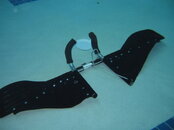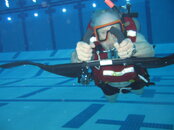Our pool, the Tualatin Hills Aquatic Center, is a competition pool, with a measured width of 25 yards and a length of 50 meters. In the summer, the lap swims are lengthwise, and in the winter the laps swims are on the width of the pool. I try to get a lane that is in the deeper part of the lap swim area, which is not actually in the deepest end. That end is reserved for different types of swimming, and is 16 feet deep due to the competition diving events of dive platforms of 10, 15 and 20 meters (I think) and a dive board too.
I always start out with a 200 yard surface swim, then start playing with my breath-hold underwater swims. I usually take no more than 3 deep breaths, and swim underwater until I feel the "must breath" signal, surface and blow out my snorkel. Sometimes I use a competition front-mount snorkel, and sometimes a regular snorkel from my collection (I have many). I relax for a minute, and start another underwater breath-hold swim, again surfacing when I get the first "must breath" signal.
I repeat this for about half an hour, and my breath-holding will gradually lengthen during that time. At 77 years old, and about 190 pounds, I'm not a competition underwater swimmer. But I note that dolphins and whales do also have some blubber, and so that doesn't bother me too much.
I also have developed underwater swimming devices, such as the "hammerhead unit" that I use in "sea turtle-dolphin" underwater swimming, using the hammerhead unit with a dolphin kick. I have been experimenting with underwater swimming techniques for decades, and this is the pool time that I use to play with these concepts.
Tualatin Hills Aquatic Center | THPRD
www.thprd.org
I always start out with a 200 yard surface swim, then start playing with my breath-hold underwater swims. I usually take no more than 3 deep breaths, and swim underwater until I feel the "must breath" signal, surface and blow out my snorkel. Sometimes I use a competition front-mount snorkel, and sometimes a regular snorkel from my collection (I have many). I relax for a minute, and start another underwater breath-hold swim, again surfacing when I get the first "must breath" signal.
I repeat this for about half an hour, and my breath-holding will gradually lengthen during that time. At 77 years old, and about 190 pounds, I'm not a competition underwater swimmer. But I note that dolphins and whales do also have some blubber, and so that doesn't bother me too much.
I also have developed underwater swimming devices, such as the "hammerhead unit" that I use in "sea turtle-dolphin" underwater swimming, using the hammerhead unit with a dolphin kick. I have been experimenting with underwater swimming techniques for decades, and this is the pool time that I use to play with these concepts.





